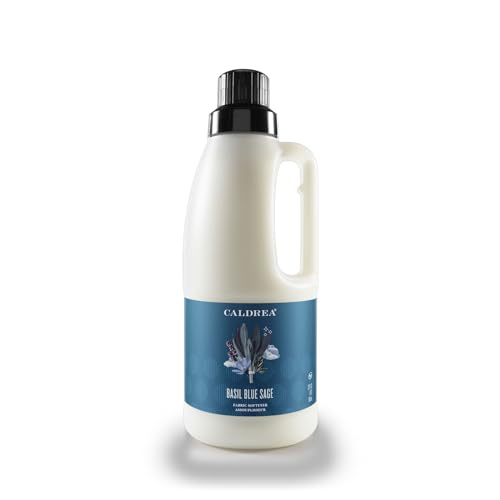
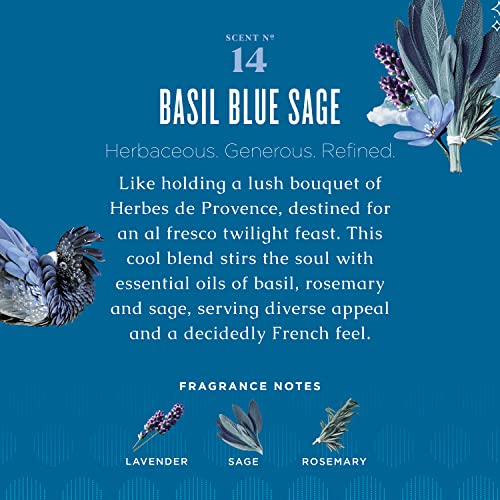
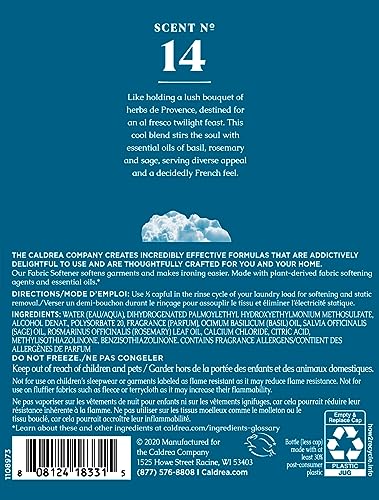
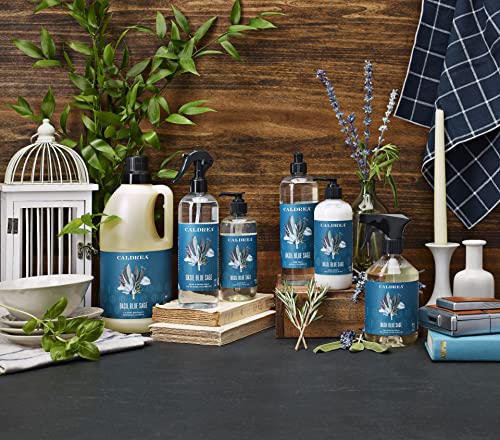

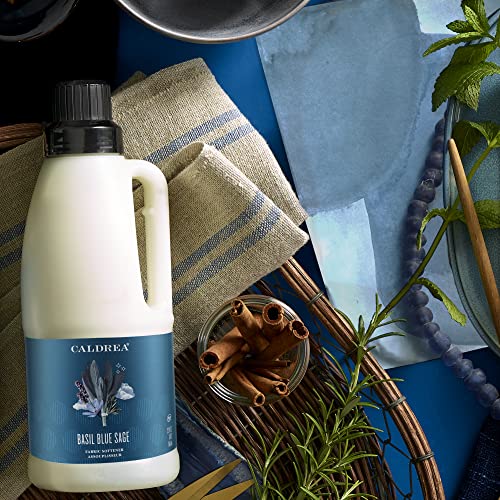
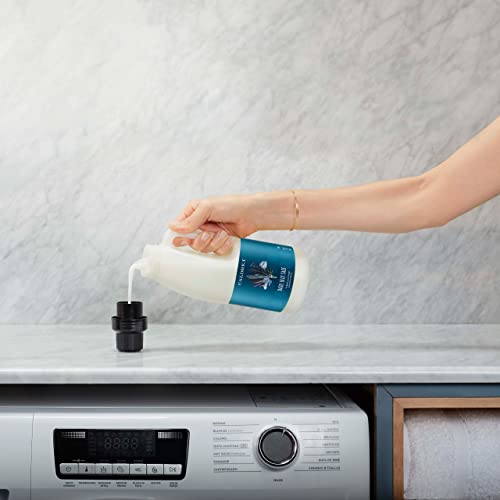
Caldrea Fabric Softener - Softens, Reduces Static & Wrinkles, Plant Derived, Basil Blue Sage - 32oz


Methylisothiazolinone
High RiskMethylisothiazolinone is a widely-used preservative in cosmetic and personal care products, known for its antimicrobial properties. It helps prevent the growth of bacteria and fungi, extending the shelf life of formulations. It is often used in leave-on and rinse-off products, including lotions and shampoos.
Sustai Insights
Methylisothiazolinone serves as an effective preservative, combating microbial growth in various personal care items. However, it is associated with a high risk of allergic reactions and skin sensitization, especially in individuals exposed repeatedly. Regulatory bodies have imposed use restrictions due to these health concerns. Additionally, while it is not considered a carcinogen, its environmental impact includes potential pollutant characteristics. Overall, the risk associated with methylisothiazolinone is high, prompting caution and consideration of safer alternatives.
Fragrance
High RiskFragrance refers to a mixture of aromatic compounds used in products to provide scent. It is commonly listed as 'fragrance' or 'parfum' on product labels and can serve various functions, including enhancing user experience and masking undesirable odors.
Sustai Insights
Fragrance offers functional benefits by improving product appeal; however, it poses significant health risks, notably a high likelihood of causing allergies and allergic contact dermatitis. Environmental risks include potential pollution and endocrine disruption, though its overall carcinogenicity is low. Regulatory bodies have noted concerns regarding its use, leading to a high-risk classification. Safe usage practices should be observed, and alternatives such as natural essential oils are recommended for those sensitive to synthetic fragrances.
Benzisothiazolinone
High RiskBenzisothiazolinone is a heterocyclic compound commonly used as a preservative in various products due to its effectiveness in preventing microbial growth. It is often found in paints, coatings, and personal care items.
Sustai Insights
Benzisothiazolinone serves effectively as a preservative, inhibiting bacterial and fungal growth, which prolongs product shelf life. However, it is associated with moderate allergenic potential and has high use restrictions due to regulatory concerns. Environmental risks include its classification as a pollutant, with potential bioaccumulation. Regulatory bodies have flagged it for unacceptable use levels in verified products, leading to an overall high-risk assessment. Safe usage practices are essential, and alternatives such as natural preservatives may be considered.
Rosmarinus Officinalis (Rosemary) Leaf Oil
Medium RiskRosmarinus officinalis (rosemary) leaf oil is extracted from the leaves of the rosemary plant. It is commonly used in cosmetic and personal care products for its aromatic properties and potential preservative benefits due to its antioxidant content.
Sustai Insights
Rosemary leaf oil offers functional benefits such as antimicrobial and antioxidant properties, which can enhance product stability. It is derived from a renewable source and is biodegradable. However, it presents moderate risks of allergic reactions and skin irritation, particularly with enhanced skin absorption. Regulatory bodies have noted restrictions on its usage in specific concentrations. The overall risk level is assessed as medium. Users are advised to follow safe usage practices and may consider alternatives like tocopherols or other natural preservatives.
Salvia Officinalis (Sage) Oil
Medium RiskSalvia officinalis (sage) oil is an essential oil derived from the leaves of the sage plant. It is commonly used in cosmetic formulations for its aromatic properties and potential skin benefits. The oil is characterized by its distinctive scent and is utilized in various personal care products.
Sustai Insights
Sage oil offers functional benefits, including antimicrobial properties and potential skin soothing effects, and is often sustainably sourced. However, it presents moderate allergenic risks and low concerns regarding carcinogenicity and reproductive toxicity. Environmental risks include potential bioaccumulation. Regulatory bodies do not currently impose significant restrictions on its use. Overall, the risk level associated with sage oil is medium, highlighting the need for cautious use, especially among sensitive populations. Alternatives may include other essential oils with similar properties but lower allergenic potential.
Water
Low RiskWater is a clear, colorless liquid essential for various biological processes. It serves as a solvent in formulations, facilitating the dissolution of other ingredients and enhancing product texture and application. Additionally, water plays a crucial role in hydration and is a key component in many cosmetic and personal care products.
Sustai Insights
Water is an effective solvent and hydrator, contributing to the texture and efficacy of formulations. It is biodegradable and generally regarded as safe, with low concerns regarding carcinogenicity, allergies, and reproductive toxicity. However, excessive water usage can lead to environmental concerns, particularly regarding resource depletion. Regulatory bodies do not impose restrictions on water use in cosmetics. Overall, the risks associated with water are low, making it a safe and essential ingredient.
Calcium Chloride
Low RiskCalcium chloride is an inorganic salt commonly used in various products for its ability to absorb moisture and as a firming agent. It is recognized for its role in food preservation, de-icing, and as an electrolyte in certain applications.
Sustai Insights
Calcium chloride serves effective moisture control and firming functions in products. It is generally recognized as safe by regulatory bodies, with low concerns regarding carcinogenicity, allergies, and reproductive toxicity. Environmental risks are minimal, and it is not bioaccumulative. Regulatory assessments indicate no current usage restrictions. Overall, it is considered low risk for human health and the environment. Safe usage practices include avoiding excessive ingestion, and alternatives like potassium chloride may be considered for specific applications.
Polysorbate 21
Low RiskPolysorbate 21 is a mixture of laurate esters of sorbitol and its fatty acid esters, commonly used as an emulsifier and surfactant in cosmetic formulations. It helps to stabilize mixtures of oil and water, enhancing texture and consistency in products.
Sustai Insights
Polysorbate 21 serves effectively as an emulsifier, contributing to product stability and texture. It presents a low risk for health concerns such as carcinogenicity, allergies, and reproductive toxicity. Environmentally, it poses minimal hazards and is not known to bioaccumulate. Regulatory bodies, including the FDA, have not imposed significant restrictions on its use. Safe usage practices should be followed to minimize skin irritation. Overall, this ingredient is assessed as low risk with no notable adverse effects or significant environmental concerns.
Rosmarinus Officinalis (Rosemary) Leaf Oil
Medium RiskRosmarinus officinalis (rosemary) leaf oil is extracted from the leaves of the rosemary plant. It is commonly used in cosmetic and personal care products for its aromatic properties and potential preservative benefits due to its antioxidant content.
Sustai Insights
Rosemary leaf oil offers functional benefits such as antimicrobial and antioxidant properties, which can enhance product stability. It is derived from a renewable source and is biodegradable. However, it presents moderate risks of allergic reactions and skin irritation, particularly with enhanced skin absorption. Regulatory bodies have noted restrictions on its usage in specific concentrations. The overall risk level is assessed as medium. Users are advised to follow safe usage practices and may consider alternatives like tocopherols or other natural preservatives.
Salvia Officinalis (Sage) Oil
Medium RiskSalvia officinalis (sage) oil is an essential oil derived from the leaves of the sage plant. It is commonly used in cosmetic formulations for its aromatic properties and potential skin benefits. The oil is characterized by its distinctive scent and is utilized in various personal care products.
Sustai Insights
Sage oil offers functional benefits, including antimicrobial properties and potential skin soothing effects, and is often sustainably sourced. However, it presents moderate allergenic risks and low concerns regarding carcinogenicity and reproductive toxicity. Environmental risks include potential bioaccumulation. Regulatory bodies do not currently impose significant restrictions on its use. Overall, the risk level associated with sage oil is medium, highlighting the need for cautious use, especially among sensitive populations. Alternatives may include other essential oils with similar properties but lower allergenic potential.
Methylisothiazolinone
High RiskMethylisothiazolinone is a widely-used preservative in cosmetic and personal care products, known for its antimicrobial properties. It helps prevent the growth of bacteria and fungi, extending the shelf life of formulations. It is often used in leave-on and rinse-off products, including lotions and shampoos.
Sustai Insights
Methylisothiazolinone serves as an effective preservative, combating microbial growth in various personal care items. However, it is associated with a high risk of allergic reactions and skin sensitization, especially in individuals exposed repeatedly. Regulatory bodies have imposed use restrictions due to these health concerns. Additionally, while it is not considered a carcinogen, its environmental impact includes potential pollutant characteristics. Overall, the risk associated with methylisothiazolinone is high, prompting caution and consideration of safer alternatives.
Fragrance
High RiskFragrance refers to a mixture of aromatic compounds used in products to provide scent. It is commonly listed as 'fragrance' or 'parfum' on product labels and can serve various functions, including enhancing user experience and masking undesirable odors.
Sustai Insights
Fragrance offers functional benefits by improving product appeal; however, it poses significant health risks, notably a high likelihood of causing allergies and allergic contact dermatitis. Environmental risks include potential pollution and endocrine disruption, though its overall carcinogenicity is low. Regulatory bodies have noted concerns regarding its use, leading to a high-risk classification. Safe usage practices should be observed, and alternatives such as natural essential oils are recommended for those sensitive to synthetic fragrances.
Water
Low RiskWater is a clear, colorless liquid essential for various biological processes. It serves as a solvent in formulations, facilitating the dissolution of other ingredients and enhancing product texture and application. Additionally, water plays a crucial role in hydration and is a key component in many cosmetic and personal care products.
Sustai Insights
Water is an effective solvent and hydrator, contributing to the texture and efficacy of formulations. It is biodegradable and generally regarded as safe, with low concerns regarding carcinogenicity, allergies, and reproductive toxicity. However, excessive water usage can lead to environmental concerns, particularly regarding resource depletion. Regulatory bodies do not impose restrictions on water use in cosmetics. Overall, the risks associated with water are low, making it a safe and essential ingredient.
Calcium Chloride
Low RiskCalcium chloride is an inorganic salt commonly used in various products for its ability to absorb moisture and as a firming agent. It is recognized for its role in food preservation, de-icing, and as an electrolyte in certain applications.
Sustai Insights
Calcium chloride serves effective moisture control and firming functions in products. It is generally recognized as safe by regulatory bodies, with low concerns regarding carcinogenicity, allergies, and reproductive toxicity. Environmental risks are minimal, and it is not bioaccumulative. Regulatory assessments indicate no current usage restrictions. Overall, it is considered low risk for human health and the environment. Safe usage practices include avoiding excessive ingestion, and alternatives like potassium chloride may be considered for specific applications.
Polysorbate 21
Low RiskPolysorbate 21 is a mixture of laurate esters of sorbitol and its fatty acid esters, commonly used as an emulsifier and surfactant in cosmetic formulations. It helps to stabilize mixtures of oil and water, enhancing texture and consistency in products.
Sustai Insights
Polysorbate 21 serves effectively as an emulsifier, contributing to product stability and texture. It presents a low risk for health concerns such as carcinogenicity, allergies, and reproductive toxicity. Environmentally, it poses minimal hazards and is not known to bioaccumulate. Regulatory bodies, including the FDA, have not imposed significant restrictions on its use. Safe usage practices should be followed to minimize skin irritation. Overall, this ingredient is assessed as low risk with no notable adverse effects or significant environmental concerns.
Benzisothiazolinone
High RiskBenzisothiazolinone is a heterocyclic compound commonly used as a preservative in various products due to its effectiveness in preventing microbial growth. It is often found in paints, coatings, and personal care items.
Sustai Insights
Benzisothiazolinone serves effectively as a preservative, inhibiting bacterial and fungal growth, which prolongs product shelf life. However, it is associated with moderate allergenic potential and has high use restrictions due to regulatory concerns. Environmental risks include its classification as a pollutant, with potential bioaccumulation. Regulatory bodies have flagged it for unacceptable use levels in verified products, leading to an overall high-risk assessment. Safe usage practices are essential, and alternatives such as natural preservatives may be considered.
Discover the transformative power of Caldrea Liquid Fabric Softener in Basil Blue Sage. This plant-derived formula not only softens and freshens your laundry but also helps eliminate static and reduce wrinkles, making your laundry day easier and more enjoyable.
- Natural Freshness: Infused with essential oils, this fabric softener delivers a refreshing scent while conditioning your fabrics.
- Static & Wrinkle Relief: Experience reduced static cling and smoother fabrics, minimizing the need for ironing after laundry.
- Eco-Friendly Ingredients: Made without phthalates, formaldehyde, artificial colors, and animal-derived ingredients, it’s a sustainable choice for your home.
- Effortless Use: Simply add 1/2 capful during the rinse cycle for optimal softening and static removal, ensuring hassle-free laundry.
- HE Compatible: Designed for high-efficiency machines, making it a versatile and convenient choice for all your laundry needs.
Caldrea's commitment to ethical practices and environmental care ensures that you can feel good about every load.
Subscribe & Save with Sustai
- Best Price Guarantee: Always enjoy the lowest prices on sustainable home essentials.
- No Surprises: We’ll notify you before shipping. No hidden fees, ever.
- You’re in Charge: Change, pause, or cancel your subscription anytime with ease.
- Eco-Friendly Deliveries: Our grouped shipments mean less packaging and lower emissions.
Join us on a sustainable journey. Special offers for a limited time! Prices and promotions may change.
Recommended Products
Discover the transformative power of Caldrea Liquid Fabric Softener in Basil Blue Sage. This plant-derived formula not only softens and freshens your laundry but also helps eliminate static and reduce wrinkles, making your laundry day easier and more enjoyable.
- Natural Freshness: Infused with essential oils, this fabric softener delivers a refreshing scent while conditioning your fabrics.
- Static & Wrinkle Relief: Experience reduced static cling and smoother fabrics, minimizing the need for ironing after laundry.
- Eco-Friendly Ingredients: Made without phthalates, formaldehyde, artificial colors, and animal-derived ingredients, it’s a sustainable choice for your home.
- Effortless Use: Simply add 1/2 capful during the rinse cycle for optimal softening and static removal, ensuring hassle-free laundry.
- HE Compatible: Designed for high-efficiency machines, making it a versatile and convenient choice for all your laundry needs.
Caldrea's commitment to ethical practices and environmental care ensures that you can feel good about every load.

You can have at most 2 Sustainable Steals products in your cart
Customer Reviews
Customers’ View
Customers appreciate the effectiveness and eco-friendly nature of the Caldrea Basil Blue Sage Fabric Softener. Many reviewers highlight the pleasant, fresh scent, describing it as amazing and masculine, which significantly enhances their laundry experience. They also praise the softening capabilities, noting that it leaves fabrics feeling soft without any residue. Functionality is another strong point, with users expressing satisfaction in its ability to reduce static and wrinkles, simplifying their ironing tasks. Additionally, the product's plant-based formulation resonates with environmentally conscious consumers, as it is crafted without harmful chemicals. Overall, customers find this fabric softener to be a high-quality option that aligns with their sustainable lifestyle.
AI-generated from the text of customer reviewsThis product has no reviews yet.




